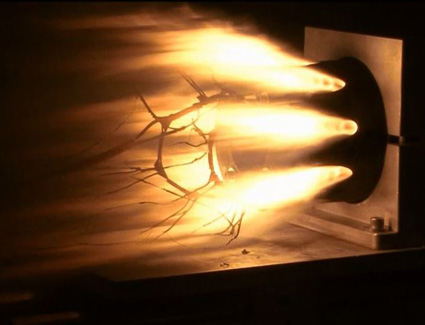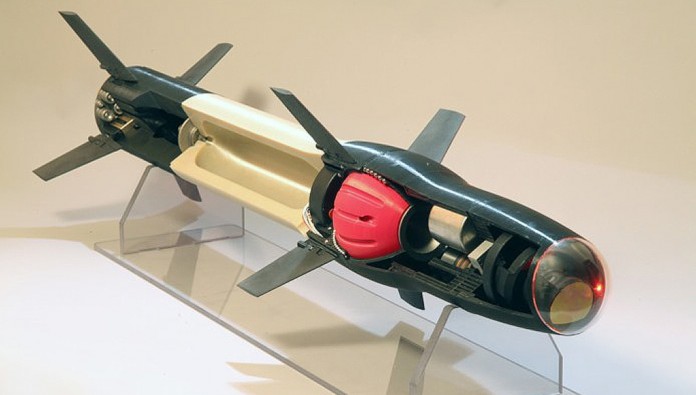Researchers at Raytheon Missile Systems say they have already created nearly every component of a guided weapon using additive manufacturing, more commonly known as 3-D printing. With commercially available high-end equipment and specially modified versions of low-cost 3-D printers, company researchers have created nearly every component of a guided weapon using 3-D printing, including rocket engines, fins, parts for the guidance and control systems, and more.
“You could potentially have these in the field,” said Jeremy Danforth, a Raytheon engineer who has printed working rocket motors. “Machines making machines. The user could [print on demand]. That’s the vision.”
The progress is part of a company wide push into additive manufacturing and 3-D printing, including projects meant to supplement traditional manufacturing processes. Engineers are exploring the use of 3-D printing to lay down conductive materials for electrical circuits, create housings for the company’s revolutionary gallium nitride transmitters, and fabricate fins for guided artillery shells.
The process may reduce costs associated with traditional manufacturing, such as machining of parts. It allows for quick design and rapid changes because engineers only need change the digital model representing the part. As long as they stay within set parameters, they can have new parts in hours instead of weeks.

“You can design internal features that might be impossible to machine,” said Raytheon engineer Travis Mayberry, who is researching future uses of additive manufacturing and 3-D printing. “We’re trying new designs for thermal improvements and lightweight structures, things we couldn’t achieve with any other manufacturing method.”
One of the new areas in weapon 3D printing is warhead design and manufacturing. Warhead designers attempt to create blast effects that meet specific criteria. “Once you get into detonation physics you open up a whole new universe,” James Zunino, a materials engineer for the U.S. Army Armament Research, Development and Engineering Center (ARDEC) said.
The limits on what can be produced using machine tools limit warhead shapes. By lifting limitations through the expanded capabilities that come with additive manufacturing, space is used more efficiently. “The real value you get is you can get more safety, lethality or operational capability from the same space,” Zunino said.
These innovative additive manufacturing processes bring together printed metals, printed energetics and other materials, layered onto substrates into the components that comprise an “initiation train” in explosive warheads. “You can vastly simplify the manufacturing of energetic materials by printing them,” Zunino said.
A major contribution of 3-D printing is its potential to streamline the manufacturing process, said Leah Hull, additive manufacturing manager for Raytheon.
“When we print something, we have fewer piece parts, so your supply chain becomes simpler,” Hull said. “Your development cycles are shorter; you’re getting parts much faster. You can get a lot more complex with your design because [you can design] angles you can’t machine into metal.”
“Ensuring consistent production integrity will be part of the next steps to realize this vision,” said Dr. Teresa Clement, a Raytheon materials expert who also serves as the chair of the executive committee of America Makes, an initiative of the National Additive Manufacturing Innovation Institute.
Other printed elements include complex electronic circuits – Engineers at the Raytheon University of Massachusetts Lowell Research Institute are developing ways to print such circuits, particularly microwave components – the building blocks of sophisticated radars. The current method of building microscopic circuits involves removing material to create a circuit pathway. In contrast, 3-D printing lays down just the material needed to build the electronic pathway.
“The word ‘printing’ implies lower cost,” said Chris McCarroll, Raytheon director for the institute. “It’s additive manufacturing. When we make integrated circuits [now], it’s all subtractive. We put down very expensive materials and wash away everything we don’t need.”
Circuits can already be printed with inkjet printers. The goal is to print more complicated circuits in three dimensions, with the very high resolution and performance of silicon.
“There’s currently a hierarchy in our manufacturing. We make the structures, the housings, the circuit cards, with the right materials, and then we integrate them into a system,” said McCarroll. “What we see in the near future is printing the electronics and printing the structures, but still integrating. Eventually, we want to print everything together. An integrated system.”
Engineers at the research institute are already able to lay down the conductors and dielectrics needed for printed electronics. They can even lay down carbon nanotubes, tiny structures made of linked carbon atoms, and are working to align them to build futuristic circuits, according to McCarroll.
So could soldiers someday print and assemble missiles on the spot, in the same way that artillery crews custom-load their rounds or weapons handlers mount guidance kits on some types of bombs? McCarroll said that’s still a ways off.
“Before a warfighter can print a missile in the field,” he said, “you need quality, controlled processes to fabricate all the component materials: the metallic strongbacks, and the plastic connectors, the semiconductors for processors, and the energetics and propulsion systems. The hard part is then making the connections between these components, as an example, the integrated control circuit that receives the command to light the fuse. At some relatively near-term point you may have to place chips down and interconnect them with printing. Or, in the future, maybe you’ll just print them.”
“We are printing demos of many of the seeker components. And we demonstrated a printed rocket motor. We’ve already printed 80 percent of what would go into a missile” said Danforth.
3D printing of missiles and warheads will allow engineers to utilize complex geometries and patterns that previously could not be produced or manufactured, driving missiles and warheads to be lighter, smaller, more compact and more affordable. It will also enable focused lethality, rendering warheads more effective, thus reducing collateral damage risk.




















